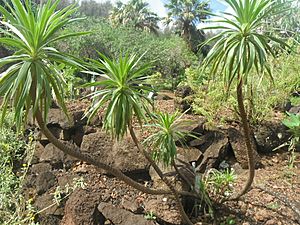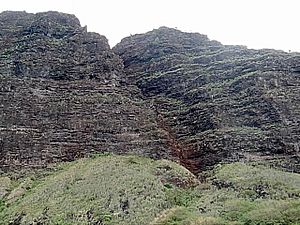Dwarf iliau facts for kids
Quick facts for kids Dwarf iliau |
|
|---|---|
 |
|
| Dwarf Iliau | |
| Conservation status | |
| Scientific classification | |
| Kingdom: | |
| (unranked): | |
| (unranked): | |
| (unranked): | |
| Order: | |
| Family: | |
| Tribe: |
Madieae
|
| Genus: | |
| Species: |
W. hobdyi
|
| Binomial name | |
| Wilkesia hobdyi H.St.John, 1971
|
|
The dwarf iliau, also known as Wilkesia hobdyi, is a special type of flowering plant. It belongs to the sunflower family and is found only on the island of Kauaʻi in Hawaii. This means it is endemic to that island.
Scientists first found this plant in 1968, but it wasn't officially named until 1971. There are fewer than 300 of these plants left in the world. Because of this, it is considered "Critically Imperiled," meaning it's in great danger of disappearing forever. The dwarf iliau has been a protected species by the government since 1992.
The Wilkesia plants are part of a group called the silversword alliance. These plants are very different in how they look, but they are all closely related. Scientists believe they all came from an ancestor plant similar to the tarweed found in North America.
Contents
What Does the Dwarf Iliau Look Like?
The Wilkesia hobdyi is a perennial shrub, which means it lives for more than two years. Its branches can grow up to 60 centimeters (about 2 feet) long. These branches grow straight up from the base of the plant.
At the end of the branches, you'll find narrow, flat leaves that look like grass. They are a bit thick and grow in a circle, not in a spiral. These leaves are usually about 7.5 to 15 centimeters (3 to 6 inches) long.
The plant produces cream-colored flowers that grow in clusters called inflorescences. Each flower cluster is about 2 centimeters (0.8 inches) across. The dwarf iliau usually flowers in the winter, but sometimes it can bloom in June too.
How Does the Dwarf Iliau Reproduce?
The dwarf iliau likely needs other plants to help it reproduce. This is called outcrossing. It probably cannot pollinate itself. Insects are the most likely helpers for pollination. Sadly, Wilkesia plants die after they flower and produce seeds.
Where Does the Dwarf Iliau Live?
The dwarf iliau lives in dry, rocky places on the western side of Kauaʻi. It prefers to grow on cliffs that are almost straight up and down. These areas are between 275 and 400 meters (900 to 1,300 feet) above sea level.
The amount of rain in these spots is very low, less than 1,200 milliliters (about 47 inches) per year.
What Threats Does the Dwarf Iliau Face?
The biggest danger to the dwarf iliau is feral goats. These are goats that live in the wild. Native plants in Hawaii, like the dwarf iliau, grew up without animals that grazed on them. So, they never developed ways to protect themselves from being eaten.
When goats were brought to Hawaii in the 1700s, they caused a lot of damage to many native plants. The dwarf iliau plants that are still alive today can only be found on very steep cliffs. These are places even goats cannot reach.
Other threats include new plant species that are not native to Hawaii. These "alien" plants, especially grasses, can grow over the dwarf iliau and smother it. These grasses also make it easier for fires to start, which can harm the plants.
Another species in the Wilkesia genus, W. gymnoxiphium, is also found only on Kauaʻi. While it's not officially endangered, it's not very common either.
Other Plants Living Near the Dwarf Iliau
The dwarf iliau often grows alongside other interesting Hawaiian plants. These include:
- ʻāhinahina (Artemisia species)
- iliau (Wilkesia gymnoxiphium)
- nehe (Lipochaeta connata)
- Lobelia niihauensis
- makou (Peucedanum sandwicense)
- kokiʻo ʻula (Hibiscus kokio)
- alaheʻe (Psydrax odorata)
- ʻalaʻala wai nui (Peperomia species)
- naio (Myoporum sandwicense)
- ʻilima (Sida fallax)
- ʻuhaloa (Waltheria indica)
- ʻaʻaliʻi (Dodonaea viscosa)
- kāwelu (Eragrostis variabilis)



